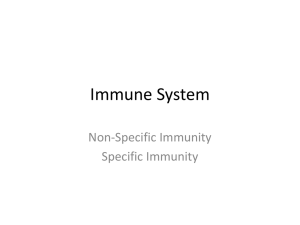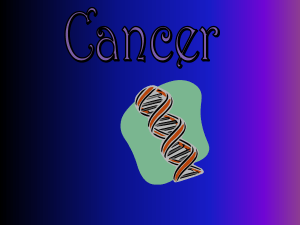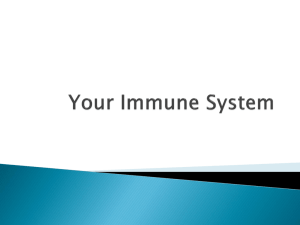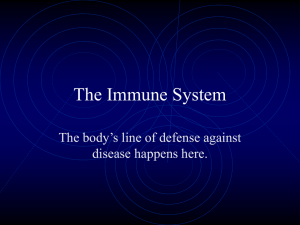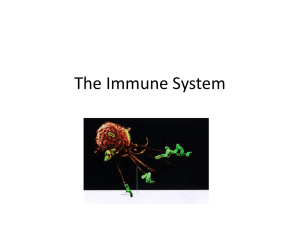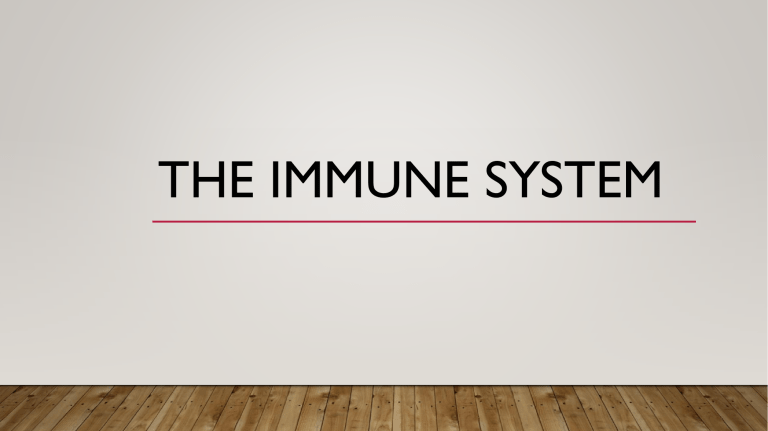
THE IMMUNE SYSTEM THE IMMUNE SYSTEM SUMMARIZED IN A VIDEO PATHOGENS • = disease causing micro-organisms • bacteria • virus • fungi, • protozoa, • parasite, • prion FIRST LINES OF DEFENCE saliva antibacterial enzymes skin prevents entry stomach acid low pH kills harmful microbes tears antibacterial enzymes mucus linings traps dirt and microbes “good” gut bacteria out compete bad SECOND LINES OF DEFENCE • Involve white blood cells • Non-specific response • invading pathogens are targeted by macrophages • Specific response • lymphocytes produce chemicals called antibodies that target specific pathogens NON-SPECIFIC RESPONSE Phagocytes PHAGOCYTES • Monocytes and macrophages • Provide a non-specific response to infection PHAGOCYTOSIS • Stages in phagocytosis 1. Phagocyte detects chemicals released by a foreign intruder (e.g. bacteria) 2. Phagocyte moves up the concentration gradient towards the intruder 3. The phagocyte adheres to the foreign cell and engulfs it in a vacuole by an infolding of the cell membrane. 4. Lysosomes (organelles which are rich in digestive enzymes & found in the phagocytes cytoplasm) fuse with the vacuole & release their contents into it. PHAGOCYTOSIS 5. The bacterium is digested by the enzymes, and the breakdown products are absorbed by the phagocyte. During infection, hundreds of phagocytes are needed. Pus is dead bacteria and phagocytes! PUS An accumulation of : - • dead phagocytes • destroyed bacteria • dead cells SPECIFIC RESPONSE LYMPHOCYTE LYMPHOCYTES Provide a specific immune response to infectious diseases. There are 2 types: - T-cells - B-cells They produce antibodies. ANTIGENS • all cells have surface markers called antigens. • body can recognise these as self or non-self (foreign) SPECIFIC RESPONSE • Lymphocytes detect presence of foreign antigens • Stimulated to produce specific proteins called antibodies. • antibodies combine with their specific antigen (like a lock and key) • this renders the pathogen harmless. • = primary response IMMUNITY • = the bodies ability to resist infection • can be natural or acquired IMMUNOLOGICAL MEMORY • after an infection is fought off some lymphocytes become memory cells. • if same pathogen returns memory cells stimulate the produce the specific antibody very rapidly. • the infection is fought off before symptoms appear = secondary response • vaccines can stimulate same response IMMUNE SYSTEM Can you… • Outline the stages in phagocytosis? • Describe how antibodies work and how they are specific? CRASH COURSE IMMUNE SYSTEM • Answer the questions as you watch this video INFLAMMATION RESPONSE • What is inflammation? LYMPHATIC SYSTEM • The lymphatic system transports and filters lymph before returning it to the blood • Parts: • Lymph • Lymph Vessels and • Lymph Nodes • Spleen Capillary exchange LYMPH • The word "lymph" comes from the Latin word lympha, which means "connected to water," • Clear colorless fluid • Contains white blood cells • Plasma leaves the body's cells once it has delivered its nutrients and removed debris. • Most of this fluid returns to the venous circulation through tiny blood vessels called venules and continues as venous blood. The remainder becomes lymph LYMPH VESSELS • Transport Lymph • Only carries it in one direction, up and towards the neck. • Lymph re-enters the circulatory system at the sub-clavien veins located on either side of the neck near the collar bones. LYMPH NODES • Filter the lymph • Major sites of B and T cells and other white blood cells. • Many located throughout the body (500-700) • Act as filters for foreign particles and cancer cells SPLEEN • Acts as a filter for blood as part of the immune system • Recycles old red blood cells • Stores platelets and white blood cells • Helps fight certain kinds of bacteria that cause pneumonia and meningitis THYMUS • Irregular-shaped gland in the top part of the chest, just under the sternum and between the lungs • The thymus serves a vital role in the training and development of Tlymphocytes or T cells, an extremely important type of white blood cell.
